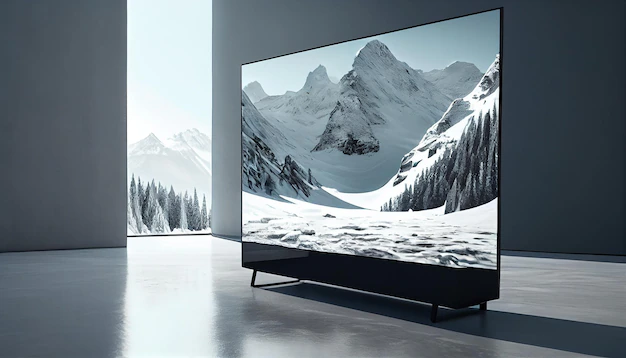
Today, we’re constantly in search of a better visual experience. It’s no longer enough to merely watch your favorite movie in high resolution; the image needs to be sharp, and clear and the colors vibrant and bright. That’s why the role of display technology has never been more crucial than today.
After all, humans are first and foremost, visual beings. From smartphones to industrial equipment, custom LCD screens are at the forefront of this revolution, offering a tailored visual experience that caters to the diverse needs of businesses and consumers alike.
As technology progressed, the standard LCD screens were no longer enough. Of course, the default size and shape of the standard scenes is still the most widespread in the market but it’s often not suitable for devices with specific sizes and dimensions. Therefore, manufacturers had to come up with a new solution and that’s when custom LCD screens entered the stage.
In the following paragraphs, we delve into the history of custom LCD screens specifically, unraveling the evolution that has led us to the cutting-edge technology we have today. We’ll also guide you through the essential considerations when choosing a manufacturer for your custom screen, ensuring you make an informed decision that aligns with your unique requirements.
The evolution of custom LCD screens
The journey of custom LCD screens began with monochrome displays in the early days of computing. These rudimentary screens paved the way for the development of more sophisticated technologies. As demand for color and higher resolutions grew, manufacturers embraced innovations, leading to the birth of color LCD screens. The ability to display a full spectrum of colors opened doors for applications ranging from consumer electronics to medical devices.
One of the pivotal moments in the evolution of custom LCD screens was the integration of Thin-Film Transistor (TFT) technology. This technology, often found in modern displays, significantly improved response times and image quality. The introduction of TFT brought about a surge in the popularity of LCD screens, making them the go-to choice for various applications, including televisions, computer monitors, and automotive displays.
As industries recognized the need for tailor-made solutions to meet specific display requirements, the era of custom LCD screens emerged. This shift allowed businesses to have screens designed with precision, catering to unique size, resolution, and functionality demands. The demand for customization skyrocketed, leading to a surge in manufacturers offering bespoke LCD solutions.
What to know before choosing a manufacturer
If you’re in need of a custom LCD screen whether it be for your personal or business-related needs, it’s all in vain unless you have a trustworthy custom LCD manufacturer you can rely on for the job. As there are many technicalities involved, someone who’s not really tech-savvy might find it challenging. So, we decided to make the process less time consuming for you and we’ve listed everything you need to know below.
Understanding your needs:
Before diving into the world of custom LCD screens, it’s crucial to have a clear understanding of your specific requirements. Consider factors such as screen size, resolution, viewing angles, and intended application. Knowing your needs will serve as a compass in selecting a manufacturer capable of delivering a product that aligns with your vision. Before you even start searching for a manufacturer, make sure you’ve outlined all your requirements. That’ll also help you narrow down your search.
Communication and approach:
Having a manufacturer you’re able to communicate with and have them explain everything in an understandable way is essential, especially if it’s your first time dealing with such a task. See if the person you choose is willing to be transparent with you and keep you updated regularly on the manufacturing progress. If you’re tied by a strict deadline, you’ll definitely value having an approachable and honest manufacturer who’ll give you regular status updates.
Technical expertise and background:
Custom LCD screens require a high level of technical expertise as mentioned above. Assess the manufacturer’s experience in designing screens for diverse industries and applications. Look for a company with a proven track record of delivering cutting-edge solutions and staying abreast of the latest technological advancements. Ask around or do a quick Internet check to see which manufacturer comes up as most recommended.
Quality assurance and testing:
The reliability and durability of custom LCD screens are paramount. Inquire about the manufacturer’s quality assurance processes and testing protocols. The process of manufacturing is important but the quality assurance stage is also essential to make sure nothing was overlooked. A reputable manufacturer will have stringent quality control measures in place, ensuring that each screen meets the highest standards before reaching the customer.
Long-term support and collaboration:
Consider the manufacturer’s commitment to long-term support and collaboration. For instance, maybe you’ll need some further consultation after the custom LCD screen is manufactured or maybe you’re planning to get another one in the near future. Opt for a partner who values customer relationships and is willing to work closely with you throughout the entire process—from initial design to post-installation support. This collaborative approach ensures that your custom LCD screens evolve in tandem with your business needs.
The key takeaways
In the dynamic landscape of modern display technology, custom LCD screens stand out a testament to the possibilities that arise when innovation meets customization. If you’re in need of this customized solution, remember that the key step is choosing the manufacturer. As we’ve emphasized above, you need to understand your unique requirements and communicate them early on. Also, don’t forget to prioritize quality assurance, and with some luck, you’ll have developed a close and long-term collaboration with the custom LCD manufacturer.
Read Also:






